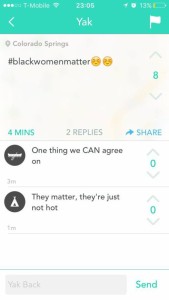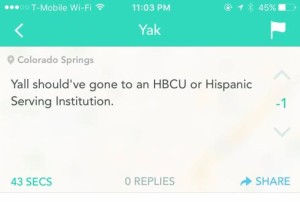Part One: Monday, Nov. 16 – Campus-wide discussion
Monday Nov. 16 began like any other first Monday at Colorado College until the clock read 9:15 a.m. Students were herded out of their classrooms by their professors to Reid Arena. Unbeknownst to them, a group of students worked with Colorado College president Jill Tiefenthaler over the weekend to set up a student-led discussion to address recent racism on campus.
As Colorado College staff, students, and faculty filed into Reid Arena on Monday morning for a mandatory discussion, the projection screen at the front of the venue quickly became the focal point of the audience as it projected a Yak that read: “Back to the cotton fields.” Just a week prior, an anonymous person posted this comment on the social media app Yik Yak, which allows users within a certain mile radius to anonymously post messages that circulate into a feed for nearby users.
On the night of Monday, Nov. 9, CC was hit by a storm of racist messages on the feed. The messages targeted people of color as well as women of color specifically.
Although the messages cycled through the feed and were down-voted soon after they were posted, a number of students managed to take screenshots of the Yaks. Screenshots circulated on a number of CC-related Facebook pages and email chains. Within 24 hours, alumni and faculty got a hold of the pictures—what followed was outrage.
Immediately, CC’s Black Student Union organized a number of emergency meetings. The three main events held that Tuesday included a discussion workshop focused on self-care and healing, a constructive discussion about the previous night’s events, and a meeting to develop an action plan. The invite was passed around a number of Butler Center groups’ listserv.
Two days later, Tiefenthaler sent out a campus-wide email to address the incident. It read: “Over this Block, we have had some difficult discussions about important topics. These are the kinds of conversations that make CC a better place and are the foundation of our learning community. We must all have the courage to continue to dialogue with each other.”
 She continued: “However, hate speech under the veil of anonymity is the work of cowards and bigots, who have no interest in community. Still, these words are hurtful and I ask that you support one another and take care of yourselves. Members of the college’s counseling staff and the chaplains are available if you need professional support. I want to remind our students that the faculty, staff, and administration of the college are here for you.”
She continued: “However, hate speech under the veil of anonymity is the work of cowards and bigots, who have no interest in community. Still, these words are hurtful and I ask that you support one another and take care of yourselves. Members of the college’s counseling staff and the chaplains are available if you need professional support. I want to remind our students that the faculty, staff, and administration of the college are here for you.”
Tiefenthaler’s remarks were followed by an email on Wednesday from the Chaplain’s Office that said: “We recognize students’ feelings of anger, hurt, and disappointment. We share your anger and are also hurt and disappointed. We pledge to stand with you and take concrete steps to make this campus a safe and inclusive place. We are here, we are listening, and we see you. Please know that you can come to any of us.”
Staff and faculty were invited to sign their name on the email as supporters during an impromptu gathering set up by Race, Ethnicity, and Migration Studies as well as Feminist and Gender Studies.
For the next few days, campus commotion began to wind down.
The events at Colorado College were only a small corner in the greater picture of race issues at colleges and universities across the U.S. While things were just getting started at CC, the University of Missouri was amidst a race war. The following timeline recaps race issues and the events leading up to the resignation of University of Missouri system President Tim Wolfe.
2010 – Two white students disperse cotton balls in front of Mizzou’s Black Culture Center.
Aug. 9, 2014 – Unarmed Michael Brown is fatally shot by police Officer Darren Wilson in Ferguson, Missouri. Mizzou fails to respond.
Sep. 12, 2015 – Payton Head, President of Mizzou’s Student Association, posts about being called the n-word the previous night by a group of students driving by in a pickup truck. Students protest the school’s lack of response through walkouts, sit-ins, and other protests.
Sep. 16 – Chancellor R. Bowen Loftin issues a statement sympathizing with students who have spoken up about bias and discrimination on campus, calling it “unacceptable.” Calls for students to stand up against hate.
Sep. 24 – Students organize a “Racism Lives Here” protest saying that the university had done nothing to address concerns or to take care of their students. According to the Missourian, no university representatives were present.
Oct. 1 – Students hold a second “Racism Lives Here” rally.
Oct. 5 – A drunk, white student interrupts the Legion of Black Collegiate’s play rehearsal by a man yelling the n-word. Chancellor Loftin posts a video message condemning the incident and tweets his response.
Oct. 6 – Faculty and students host a sit-in against racism and the administration’s lack of action.
Oct. 8 – Loftin announced that mandatory online diversity and sensitivity training would start in January for all students, staff, and faculty.
Oct. 10 – A group of student protesters with Concerned Student 1950 (the name referring to the first year black students were admitted to Mizzou) block Tim Wolfe’s car during Mizzou’s homecoming parade to voice their concerns in light of recent events. Some students say that police used excessive force to clear out the streets.
Oct. 11 – Students hold a third “Racism Lives Here” rally. University police cuts the event short.
Oct. 20 – Mizzou’s Concerned Student 1950 announces a list of eight demands that include Tim Wolfe’s apology and resignation.
Oct. 24 – Someone draws a swastika using feces in a dorm bathroom; this was the second reported anti-Semitic accident in a residence hall at Mizzou that year.
Oct. 27 – Wolfe meets with members of Concerned Student 1950, ends with no resolution.
Nov. 2 – Jonathan Butler, a graduate student at Mizzou, announces his hunger strike, vows not to eat until Wolfe resigns or until he dies.
Nov. 3 – Wolfe issues a statement expressing his concern for Butler and offers to discuss alternative ways to cause change.
Nov. 4 – Mizzou’s English Department draws a 26-0 vote, showing no confidence in Chancellor Loftin.
Nov. 5 – Staff, faculty, and students organize a walkout to support Butler’s hunger strike.
Nov. 6 – Wolfe issues a late apology to Concerned Student 1950 for his response to the Homecoming Parade incident.
Nov. 7 – Football players of color go on strike, refusing to play in any games until President Wolfe resigns.
Nov. 8 – The entire football team joins the strike. Wolfe releases a statement insisting that he refuses to resign. Missouri State Senator Clair McCaskill issues a statement that calls for action from the university. Two Republican Missouri lawmakers issue statements calling for Wolfe’s resignation.
Nov. 9 – The Missouri Students Association’s executive cabinet says that the administration has failed them. A few hours late, Wolfe resigns.
Nov. 10 – Mizzou’s Yik Yak feed is perturbed by anonymous threats to kill all black people on campus. Payton Head, Student Body President, claims seeing the KKK on campus; he later apologizes for the false claims.
Nov. 11 – Mizzou issues a timely safety warning to the campus at 8:30 a.m. Hunter Park and Connor Cottlemyre are arrested for posting the threats on Yik Yak; neither attend the university. Black students set up a safe space in the Black Culture Center for their safety and begin walking to class in large groups. Concerned Student 1950 divides protesters into black and white groups saying that students needed a “black-only healing space.”
 Part Three: Colorado College moving forward
Part Three: Colorado College moving forward
In the case of both Mizzou and CC, it is clear that the fight is far from over.
Monday’s events left students with a lot to reflect. Perhaps the most compelling part of the event was when students shared their narratives, comments, and concerns, speaking into the microphones passed around the audience.
Students told many stories of microaggressions that they felt on campus as well as the difficulties they experience as a person of color on a predominantly white campus. Currently, the school has not provided guidance for any steps moving forward; this has caused a mixed response from attendees.
“I didn’t think it was efficient, and it took the school too long to react,” said junior Serena Dunbar. “This problem has existed since I was a freshman and this is the first time something has been done.”
Junior Jennifer Murray also has her doubts on the efficiency of the event.
“The event was a step in the right direction because it’s so important for POC to share their stories on campus,” said Murray. “However, I don’t think there was a clear follow-up plan so it will be interesting to see what comes from this.”
On the other hand, some attendees including Residential Life and Programs Coordinator Zachary Kroger felt that the response was timely and left attendees with a lot to ruminate.
“I think having the assembly was really powerful,” said Kroger. “At least from my perspective, it was quite moving to see the passion from so many students who were impacted by the comments. The worst thing a school could do is just to sweep it under the rug, so I think the timeliness and seriousness in which the response happened was very good.”
 Although the next steps remain unclear, many people remain hopeful. The fact that the event occurred at all is a telling sign of concern from administration as well as the potential to make a change.
Although the next steps remain unclear, many people remain hopeful. The fact that the event occurred at all is a telling sign of concern from administration as well as the potential to make a change.
Associate Professor and Associate Chair & Title IX Coordinator, Gail Murphy-Geiss, suggests that perhaps the reason why now is the time for this kind of action to take place is because the college is finally “ready.”
“I love that we’re actually talking about these issues, but I also realize that for many, this is not fun – it is personal and even frightening,” said Murphy-Geiss. “As a sociologist, I’d also say that I’m not surprised. That is, it’s time. I think one of the main reasons we are having these discussions now is that we now have enough students and faculty of color to create a “stir” (for lack of a better word).
She continued: “Some scholars of social movements say that when an organization has only a few minorities, they are treated as tokens and they act accordingly…But once the organization hits the 20-30% mark, the voices begin to combine and the volume gets turned up and let’s just say things get messy. I’d say that’s where we are now, and I’m happy about that. I’m excited to see what is on the other side, but this is the path that we have to travel to get there, and I welcome it. It’s time.”
Candelaria Alcat
Latest posts by Candelaria Alcat (see all)
- The Follow-Up: A deeper look at racial tensions at Yale – Dec 4, 2015
- Yik Yak controversy on campus reflects nationwide issues about race – Dec 1, 2015
- CC students push college to adopt Indigenous Peoples’ Day – Oct 25, 2015

